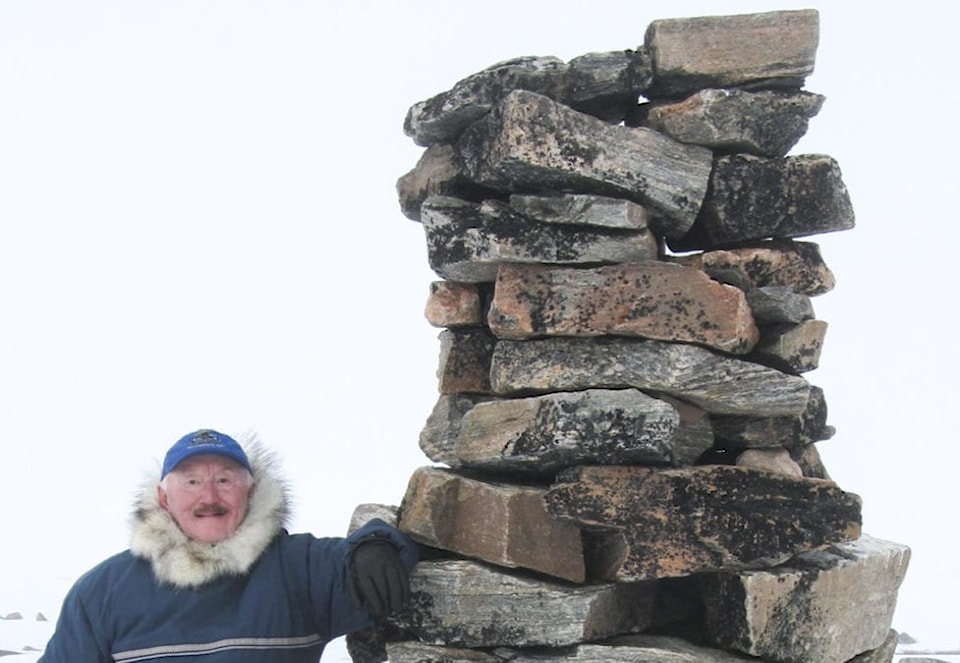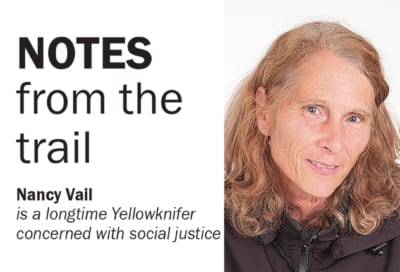The inukshuks displayed at most visitor sites throughout the NWT stand tall and bold with their outstretched arms. Contrary to popular opinion, though, they are not signs of goodwill. In fact, they are the opposite. Traditionally, outstretched arms mean STAY AWAY; DANGER something terrible has happened here; a murder, a suicide, there are bad spirits around.
How's that for a surprise?
That is what I learned in my first visit to the Healing Camp behind the multiplex in July when councillor Annie Maria Mitsima, an Inuit herself, described how she had redesigned the Inukshuk there after talking to world expert Piita Irniq.
Mr. Irniq was a three-time MLA in the territories and one-time commissioner of Nunavut. Since leaving office in the early 2000s, he has spent his time traveling the world to learn about his culture, lost when the Inuit were forced to attend residential school.
We often forget that the Inuit, a gentle, humble and helping people rich in character and personality and a fundamental part of the Canadian mosaic, had a sophisticated culture of their own before colonization. Mr. Irniq also spends his time describing his experiences in those schools to help other Inuit come to terms with their own and heal in the process.
For example, did you know there are more than 25 different styles of inukshuks with a wide variety of meaning designed to tell travellers and hunters everything from where animals and caches of supplies can be found to the intensity and direction of wind and water currents? Some have a gap deliberately built into their centres acting as periscopes to pinpoint important signposts to help with a safe journey. Most of all, with the exception of the inukshuk with outstretched arms (the one most often reproduced by amateur rock assemblers), these rock people as they are called are intended to send out the message that visitors are safe here and protected by generations of ancestors who have visited before them.
Because of his extensive knowledge, Mr. Irniq has been commissioned to build them in Ottawa, on the Beaches of Normandy, for the British Museum, in Paris for the Paris Climate Change talks in 2015 and more than 100 throughout the U.S. Knowing that, it is surprising that we do not see more built not only on the Northwest Territories but throughout Canada.
The Inuit are our people and have made us what we are by sacrificing by choice or by force lifestyles that made living here possible. They were relocated on many occasions in the high Arctic, particularly during the Cold War, so that the world would know Canada had a presence in our vast North. It was the Inuit who safeguarded our points of entry in the most trying of times.
Knowing the significance of the Inuit to the Canada mosaic and what they have sacrificed so that we could live here safely, it is surprising we do not have more services such as a treatment centre available for them during this time of their recovery. While they can be assertive, they are not pushy or aggressive – it is not part of their character. Being helpful is.
Our shelters, sobering centres and prisons are filled with Indigenous people because of these oversights. When these people who have lived along the shores of the high Arctic for so long tell us that climate is causing irrevocable damage, do we listen? Do we listen when they say their food supplies are being exhausted and that their homes are disappearing into the ocean? Do we give them the help they need and do we even know what that is?
The Inuit may be an old culture, but as the inukshuks tell us, it is a wise one, perfectly in tune with the land and likely far more accurate than many of our own sophisticated technology.
When Mr. Irniq travels to Yellowknife hopefully this fall, it would be wonderful for Yellowknifers to meet him at least halfway. The Inuit have always been there for us … maybe it is time for us to be there for them.

